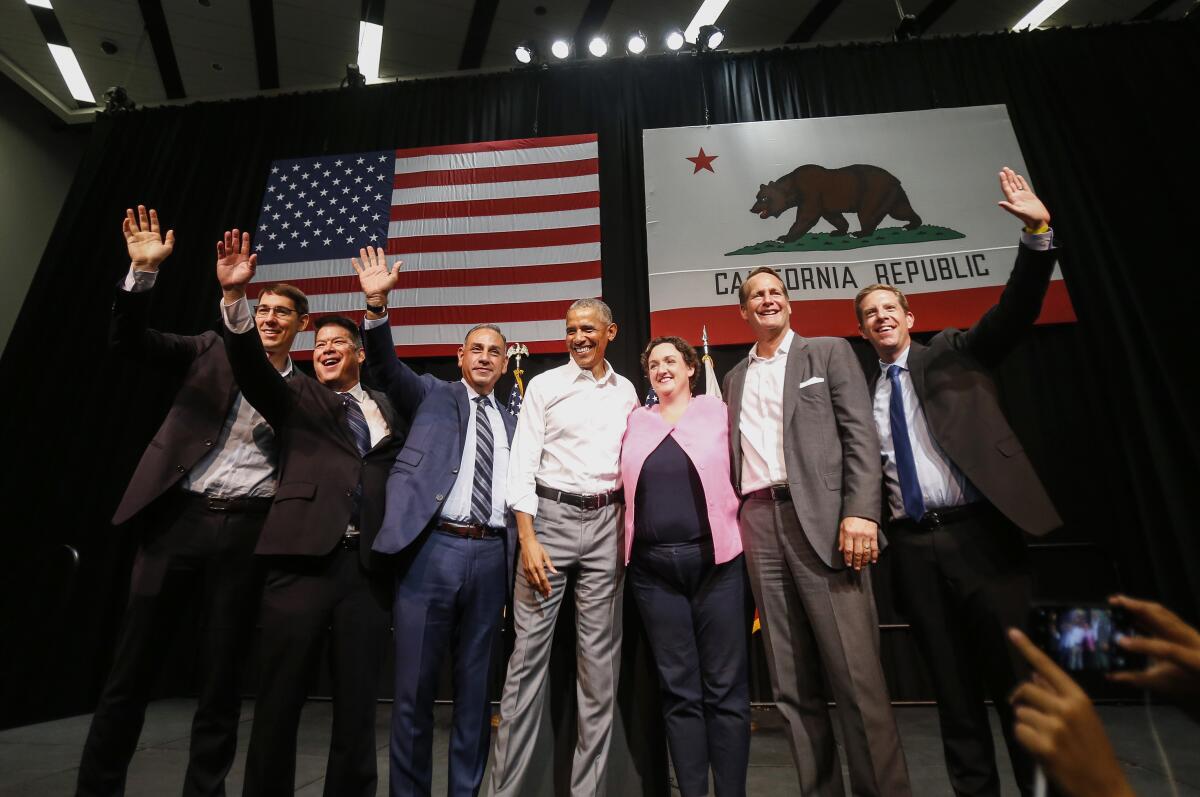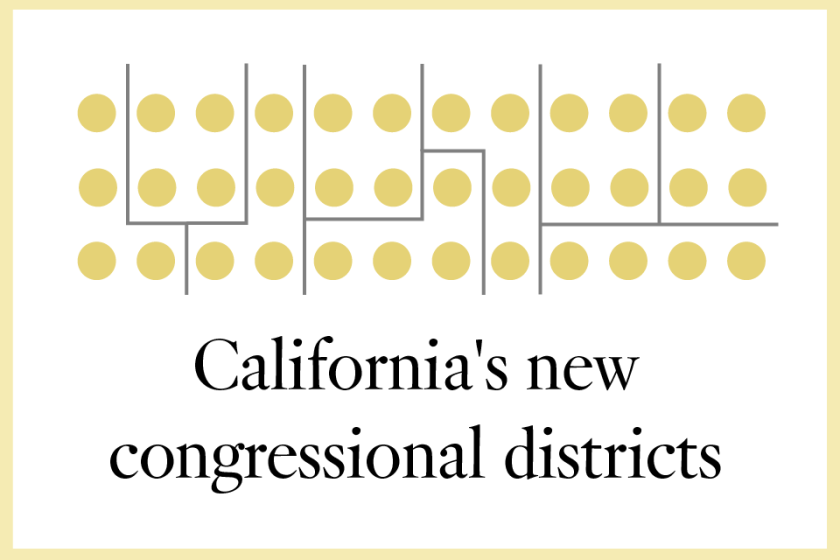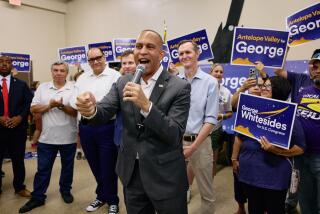With California’s congressional maps set, candidates swoop in

After months of stall as they waited for new district lines, California’s congressional incumbents and challengers rushed to declare their candidacies Tuesday as key matchups, including a potential high-stakes contest between Orange County Democrats, began to crystallize.
The redrawing of California’s congressional, legislative and Board of Equalization boundaries will shape the contours of the state’s political landscape for the next 10 years. Politicians, however, immediately turned their attention to a more pressing question for the next 11 months — where they will run in the 2022 midterm election.
Soon after the state’s independent redistricting commission approved the new maps — in some cases, within minutes of the vote — incumbents had announced reelection plans and specified which of the reconfigured seats they’re seeking.
The flurry of announcements underscored how antsy California politicians are to introduce themselves to new voters, scope out potential challengers and, in some cases, physically relocate, in response to the commission’s work.
“We have our maps now. We’re talking to all of our members to see who’s running where,” said Jessica Patterson, chair of the California Republican Party. “We will be pushing on those [recruited] candidates we think are ready to step up to the next level.”
California has a new congressional map after losing a seat due to relatively flat population growth. Use this interactive map to explore the state’s new political boundaries.
The new district lines were not drawn according to partisan considerations — the independent commission is not allowed to take partisanship into account. But the lines were broadly good news for the Democratic Party. All of the seats now held by Democrats will tilt even more blue with the new boundaries. By contrast, five of the 11 seats held by Republicans will grow more competitive.
But the shuffling has led to at-times awkward maneuvering for candidates of both parties, especially in Orange County and the Central Valley, two of the most politically contested parts of the state.
So far, two Democrats find themselves on a potential collision course: Rep. Katie Porter and former Rep. Harley Rouda both intend to run in a coastal Orange County district that includes Porter’s hometown of Irvine and Rouda’s home in Laguna Beach.
The seat is currently held by GOP Rep. Michelle Steel of Seal Beach, who narrowly defeated Rouda in 2020.
Rouda had been vowing a rematch, insisting he would win back that territory in 2022. A spokesman said Tuesday that Rouda still planned on running in that coastal district.
But Porter, who has carved out a national profile for her whiteboard presentations during congressional hearings, also announced she would run for the seat.
“Roughly two-thirds of voters in the 47th District have not previously been represented by Congresswoman Porter, and she looks forward to introducing herself to these voters and running a positive and spirited campaign,” said Jordan Wong, a Porter campaign spokesperson.
Nearly one-third of state’s districts in Congress would have Latino majorities under independent commission’s plan. The new map also endangers some GOP incumbents.
The intraparty fight could prove costly — both financially and politically.
Porter is one of the top fundraisers in the House and has more than $14 million cash on hand as of September. Rouda, a wealthy businessman, has about $600,000 in the bank and raised millions for both his 2018 and 2020 campaigns; in his first race, he loaned his campaign nearly $2 million.
The seat is expected to be one of the most hotly contested in California next year; voters in the district backed President Biden by nearly 11 percentage points in 2020, but Republicans hold a tiny registration advantage.
The prospect of a Democrat-on-Democrat fight cheered Patterson, the GOP state chair.
“When it comes to Democrats, the more the merrier,” she said.
The next key moves could come from Steel and her fellow Orange County Republican, Rep. Young Kim.
Steel could run in the newly formed coastal district or go further inland to the neighboring district that encompasses Little Saigon, Fullerton and Brea. Kim could also run in that district or in a seat that includes the cities of Orange and Yorba Linda.
Members of Congress do not need to live in their districts.
“They have a bit of flexibility,” said Rob Pyers, research director for the nonpartisan election almanac California Target Book. “There are two Republican-leaning seats, and these are two incumbents that have been longtime friends. I’m sure they’ll work something out.”
A consultant for both congresswoman said Monday the lawmakers were weighing their options.
Their decisions will have ripple effects. Former Orange County GOP Chairman Scott Baugh, for example, said Tuesday he would run against Porter and Rouda if Steel decides to head inland.
“Michelle hasn’t made her choice yet, and I’ll support her in whatever district she chooses,” Baugh said.
A handful of challengers also made moves Tuesday, including Democrat Jay Chen, who plans to run in the Little Saigon district. But the bulk of the action came from incumbents.
Democratic Reps. Doris Matsui of Sacramento and Jim Costa of Fresno quickly announced their reelection plans, for example, with ripple effects for other members.
“What we’re seeing is a bunch of members staking out their territory, and we’ll see who moves around them,” said Andrew Acosta, a Democratic strategist based in Sacramento.
“Everybody has to figure out what’s best for them. The person next door will have to bounce to the next district over to avoid these Democrat-on-Democrat races that are potentially out there.”
The maneuvering was apparent on the Republican side as well. Assemblyman Kevin Kiley announced his intention to run in a Northern California district that includes parts of Sacramento and Placer counties, currently occupied by GOP Rep. Tom McClintock. Kiley, in a statement, said he believed McClintock, whose wife, Lori, died this week, will decide to run in a solidly Republican district just south of his current seat.
Unlike members of Congress, state legislators have strict residency requirements. Some signaled that house hunting is in their future, like Assemblywoman Luz Rivas, who tweeted that she was “moving soon” to relocate within the new boundaries of her San Fernando Valley district.
For some, the new maps were enough to quash future political plans.
Assemblyman Devon Mathis, a Republican from Visalia, had considered running for the congressional seat occupied by GOP Rep. Devin Nunes, who is stepping down to lead former President Trump’s new media venture. But under the new boundaries, the district will become dramatically more Democratic.
“While I truly appreciate the excitement and supporters pushing me to make a run at Congress, it’s simply not in the cards with the new maps,” Mathis wrote on Twitter. He’ll be running in a new Assembly district instead.
More to Read
Get the L.A. Times Politics newsletter
Deeply reported insights into legislation, politics and policy from Sacramento, Washington and beyond. In your inbox three times per week.
You may occasionally receive promotional content from the Los Angeles Times.















